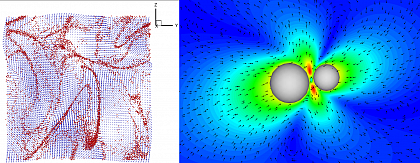Turbulent colloidale systems
Grant number:
SO 204/33-3
Title:
Simulation of turbulent colloidal systems and prediction of the agglomerate morphology
Head:
Prof. Dr.-Ing. M. Sommerfeld
Staff:
Dipl.-Ing. (FH) Martin Ernst
Keywords:
Colloidal systems, Agglomeration, Turbulent flow, Lattice Boltzmann Method, Modelling
Description:
The objective of this project is the analysis of the elementary mechanisms, which affect the formation process and the morphology of agglomerates in turbulent colloidal systems. Direct numerical simulations of particle-laden flows are performed to characterise the agglomerate structure as a function of different factors of influence. The factors of influence contain for example the flow and turbulence structure (homogeneous isotropic turbulence, shear flow), the fluid-dynamic transport of particles taking into account all relevant forces and torques, the Brownian diffusion and the interaction potential.
The simulations are performed using a three-dimensional Lattice Boltzmann Method (LBM) which is originated from molecular dynamics. Whereas conventional CFD models are based on the conservation laws formulated on the macroscopic level, the Boltzmann equation describes the behaviour of fluids on the mesoscopic level. Hence, the LBM is very suitable for the analysis of particle systems with complex geometry. Suspended primary particles and agglomerates are described by a hybrid approach (Lagrangian approach and highly-resolved particle structures). At first the fluid-mechanical transport of the injected primary particles is modelled under assumption of mass points (Lagrangian approach). In order to incorporate the interaction with the fluid the structure of the corresponding collision partners are resolved by a local grid refinement. The switchover between both approaches is done shortly before a collision occurs. The structure of the resulting agglomerates is further resolved by a moving local grid refinement. Non-agglomerating primary particles are transformed again into the Lagrangian approach.
In simulations the formation, the restructuring and the breakaup of agglomerates are to be considered. The long-term objective is to predict the agglomerate morphology as a function of different factors of influence.

Isotropic turbulence and particles in contact
This project is financially supported by the DFG priority program 1273 "engineering of colloidal systems" .Publications in journals:
Ernst, M., Sommerfeld, M.: On the Volume Fraction Effects of Inertial Colliding Particles in Homogeneous Isotropic Turbulence. J. Fluids Eng. (134), 031302 (2012); Link to the publication.
Schlauch, E., Ernst, M., Seto, R., Briesen, H., Sommerfeld, M., Behr, M.: Comparison of three simulation methods for colloidal aggregates in Stokes flow: finite elements, lattice Boltzmann and Stokesian dynamics (under review).
Ernst, M., Dietzel, M., Sommerfeld, M.: A Lattice-Boltzmann method for simulating transport and agglomeration of resolved particles (under review).
Publications in refereed conference proceedings:
Ernst, M., Sommerfeld, M.: Direct numerical simulations of colliding particles suspended in homogeneous isotropic turbulence. 2009 ASME Fluids Engineering Division Summer Meeting, Vail, Colorado, USA, Paper No. FEDSM2009-78072 (2009).*
Laín, S., Ernst, M., Sommerfeld, M.: Colliding Particle-pair Velocity Correlation Function in Turbulent Flows. 7th International Conference on Multiphase Flow, Tampa, Florida, USA, Paper No. ICMF2010-9.5.3 (2010).
Ernst, M., Laín, S., Sommerfeld, M.: Analysis of inter-particle collision effects in homogeneous isotropic turbulence using point-particle DNS based on the Lattice-Boltzmann-Method. 2010 ASME Joint U.S. - European Fluids Engineering Summer Meeting, Montreal, Canada, Paper No. FEDSM-ICNMM2010-31321 (2010).
Dietzel, M., Ernst, M., Sommerfeld, M.: Application of the Lattice-Boltzmann method in two-phase flow studies: From point-particles to fully resolved particles. 2011 ASME-JSME-KSME Joint Fluids Engineering Conference, Hamamatsu, Shizuoka, Japan, Paper No. AJK2011-04033 (2011).
Awards:
*2010 Robert T. Knapp Award given for an outstanding original paper by the Fluids Engineering Division of ASME (Paper No. FEDSM2009-78072).





